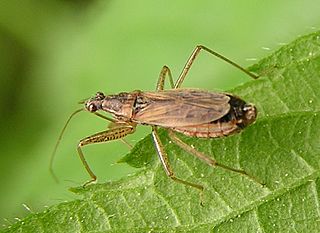
The Celastraceae are a family of 98 genera and 1,350 species of herbs, vines, shrubs and small trees, belonging to the order Celastrales. The great majority of the genera are tropical, with only Celastrus, Euonymus and Maytenus widespread in temperate climates, and Parnassia (bog-stars) found in alpine and arctic climates.

The insect family Nabidae contains the damsel bugs. There are over 500 species in 20 genera. They are soft-bodied, elongate, winged terrestrial predators. Many damsel bugs catch and hold prey with their forelegs, similar to mantids. They are considered helpful species in agriculture because of their predation on many types of crop pests.

Anthocoridae is a family of bugs, commonly called minute pirate bugs or flower bugs. Worldwide there are 500-600 species.

Cryptophagidae is a family of beetles with representatives found in all biogeographic realms. Members of this family are commonly called silken fungus beetles and both adults and larvae appear to feed exclusively on fungi although in a wide variety of habitats and situations, such as rotting wood and shed animal fur and feathers. These beetles vary from about 1 to 11 millimeters long, and usually have an oval body shape with a slight "waist".

Anthribidae is a family of beetles also known as fungus weevils. The antennae are not elbowed, may occasionally be longer than the body and thread-like, and can be the longest of any members of Curculionoidea. As in the Nemonychidae, the labrum appears as a separate segment to the clypeus, and the maxillary palps are long and projecting.

Myopsocidae is a family of mouse-like barklice, belonging to the infraorder Psocetae of the order Psocodea. This family is closely related to Psocidae, with which it shares similar wing-venation, but from which it is distinguished by three-segmented tarsi.

Schaefferia frutescens, the Florida-boxwood, is a species of flowering plant in the family Celastraceae, that is native to tropical regions of the Americas, from southern Florida in the United States, south through the Caribbean to Central America and northwestern South America, and also Veracruz in Mexico. It grows at close to sea level in Florida, and up to 600 m altitude in Puerto Rico.

Schaefferia is a genus of flowering shrubs and small trees in the family Celastraceae. The generic name honours German mycologist and clergyman Jacob Christian Schäffer (1718–1790). Members of the genus are found in the Neotropics. The plants are dioecious, with flowers that are unisexual due to abortion. The flowers are usually clustered in the leaf axil, although they are solitary in some species. The calyx of the flowers has four lobes, and the corolla consists of four petals. The ovary consists of two locules; each locule contains a single ovule which develops into a single seed. The fruit is a drupe.

Clivina is a genus of ground beetle native to the Palearctic, the Nearctic, the Near East and North Africa. There are more than 600 described species in Clivina.

Sphindidae is a family of beetles, in the suborder Polyphaga. They are called slime mold beetles due to their exclusive feeding on slime molds during adult and larval stages, other aspects of their life history are obscure. Palaeontological discoveries since 2015 have added to the geologic history of Sphindidae, including the discovery of Libanopsis, placed in the extinct subfamily Libanopsinae.

Hypogastruridae is a family of springtails. Members of the family are common and widespread with a cosmopolitan distribution of about 660 species in about 40 genera.

The Taiwanese brown-toothed shrew is a species of shrew in the tribe Nectogalini. It is found only in Taiwan. It prefers dense ground cover in forests and subalpine shrublands in high mountains of central Taiwan. Its placement in Episoriculus has been questioned, with genetic analysis finding that it is more basal within Nectogalini than other members of Episoriculus.

Lixus is a genus of true weevils in the beetle family Curculionidae, raised by the Danish entomologist, Johan Christian Fabricius in 1775. There are at least 950 described species in Lixus.

Trachyderini is a tribe of long-horned beetles in the family Cerambycidae. There are at least 140 genera and 650 described species in Trachyderini.

Periscelididae is a family of flies.

Plutomurus ortobalaganensis is the deepest terrestrial animal ever found on Earth, living at 1,980 metres (6,500 ft) below a cave entrance. It is a species of springtail (arthropods) endemic to the Krubera-Voronja cave system in Abkhazia, Georgia. It was discovered in the CAVEX Team expedition of 2010. It feeds on a few fungi and decomposing organic matter in the caves.
Schaefferia profundissima is a species of springtail (arthropods) endemic to the Krubera-Voronja cave system in Georgia. It is one of the deepest terrestrial animal ever found on Earth, living at >1,800 metres (5,900 ft) below the cave entrance. It was discovered in the CAVEX Team expedition of 2010.

Valenzuela is a genus of psocoptera in the family Caeciliusidae, the lizard barklice. Some species are extinct and date to the Eocene of Poland or Russia. There are at least 300 described species in Valenzuela.

Schaefferia is a genus of springtails in the family Hypogastruridae. There are at least 20 described species in Schaefferia.
Schaefferia is the scientific name of two genera of organisms and may refer to:

















